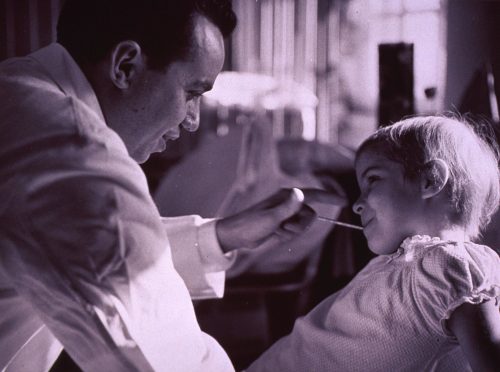During a sick call or an annual check-up, one of the first measurements collected by the doctor is the patient’s body temperature. Courtesy of Roy Perry on Wikimedia Commons.
When you go to the doctor, the first measurement taken—whether it’s an annual check-up or a sick call—is your body temperature. Over the years, the method has varied, from mercury thermometers under the armpit to infrared thermometers scanned over the forehead. But the standard indicator of health has remained the same since 1851, when it was first reported by the German physician Carl Reinhold August Wunderlich. As you’ve probably heard before, the normal human body temperature is 98.6 degrees Fahrenheit.
Julie Parsonnet and her colleagues at Stanford, however, have found evidence that disrupts this paradigm: they recently reported that that human body temperature has steadily decreased over the past two centuries to a current average of 97.9 degrees Fahrenheit. In the most comprehensive analysis to date, their study examined hundreds of thousands of temperature measurements from three databases ranging from the end of the Industrial Revolution to present day. In the end, they found a constant decrease in temperature from decade to decade.
Parsonnet’s study is important not because it shows that human body temperature is lower but because it shows that it has dropped since the nineteenth century. Medical professionals have known for the past few decades that healthy human body temperature is lower than the 98.6 degrees Fahrenheit standard. A Russian pharmacy chain founded in 1991 is even named 36.6—the Celsius equivalent to 97.9 degrees Fahrenheit—in honor of the more accurate lower temperature. Scientists previously assumed that 98.6 degrees Fahrenheit must have been wrong at the time of measurement as well, blaming differences in historical measurement methods and instrument calibration. According to Parsonnet, the original number may not have been wrong at all. It is just no longer accurate for modern humans. The question is: why?
“Temperature is a marker of metabolism,” Parsonnet said. With lower body temperatures, our metabolism must be slower. Perhaps this change is caused by our more temperate environments. With heating and air conditioning, modern Americans live in the “thermoneutral zone” of sixty-four to seventy-two degrees Fahrenheit in which our bodies do not have to increase metabolism to keep warm. With inactive modes of transport and sedentary desk jobs, we also move less, further suppressing our metabolic rate and possibly explaining the rise in obesity.
Parsonnet prefers an alternate explanation: our cleaner environments. Thanks to sewage systems, hand sanitizer, antibiotics, and modern infrastructure, we have decreased the rates of formerly widespread infections, such as syphilis, rheumatic heart disease, and tuberculosis. Thanks to vaccination, we have minimized infectious diseases of the past and have hopes to apply the same to infectious diseases of the present. All of this leads to decreased inflammation, which in turn leads to lower metabolism and thus a lower body temperature. It is uncertain whether this decreased inflammation is true everywhere; the modern temperatures in the study were collected in the United States. Moving forward, Parsonnet is interested in examining temperatures in developing countries as well.
If the “normal” human body temperature is lower, does this challenge the way we approach fever and medical diagnosis? Though taking your temperature may be the first thing your doctor does, it is never the last. Think about the family history, blood pressure readings, throat swabs, blood draws, and everything else that goes into a sick call. We are drawn towards binaries: sick versus healthy, feverish versus normal. But temperature varies from person to person and even within a person over the course of a day. The real question is not why our 98.6 degrees Fahrenheit standard was wrong but rather why we rely on it so heavily when every person is an individual. There is no overall “normal” human standard. Instead, “There is a ‘normal’ for each person that depends on their age, sex, weight, height, and the time of day their temperature was measured,” Parsonnet said. Her team is already working on an algorithm that determines what is abnormal for an individual patient at any particular time. In the age of big data and personalized medicine, we are beginning to see patients as individuals instead of averages. Today, we are surprised that the 98.6 degrees Fahrenheit standard has been replaced by 97.9 degrees Fahrenheit. In the future, we may be surprised that we relied on an average at all.
Sources:
Barondess, J. (2014). Scanning the Chronic Disease Terrain: Prospects and Opportunity. Transactions of the American Clinical and Climatology Association, 125(2014), 45-56.
Fischer, K. (2020, January 20). Forget 98.6 degrees Fahrenheit. Humans Are Cooling Off — Here’s Why. Healthline.
Protsiv, M., Ley, C., Lankester, J., Hastie, T., & Parsonnet, J. (2020). Decreasing Human Body Temperature in the United States Since the Industrial Revolution. eLife 9e49555.

